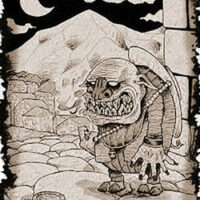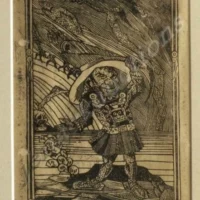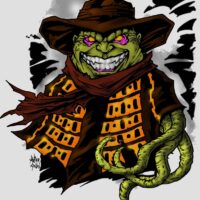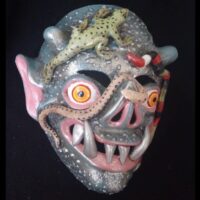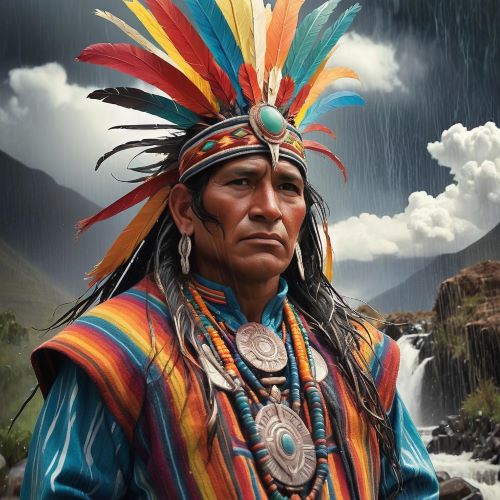Anchanchu : The Sinister Guardian
Listen
At a glance
| Description | |
|---|---|
| Origin | Aymara Mythology |
| Classification | Hybrids |
| Family Members | N/A |
| Region | Bolivia, Peru |
| Associated With | Shapeshifting, Gold, Blood Sucking, Deception |
Anchachu
Introduction
Anchanchu stands as one of the most enigmatic figures in Aymara mythology, a sinister presence haunting the isolated and liminal spaces of the Andean highlands. Found in the traditional lore of Bolivia, Peru, and parts of Chile, Anchanchu is not just a character in myth but a cautionary embodiment of fear, greed, and spiritual imbalance. He represents the unseen dangers that lie in remote places and the consequences that befall those who enter sacred or forbidden domains without proper respect. With roots in the spiritual world of the Aymara, Anchanchu occupies a significant role as a being tied to the forces of the underground and the darker aspects of human nature.
Physical Traits
Anchanchu is a creature of many faces, reflecting the varied cultural landscapes of the Andean peoples. His most recurring form is that of an older man—bald, squat, and disfigured—whose appearance inspires immediate dread. Other versions describe him as a red dog prowling the night in Huancané, particularly during the hours just after midnight. His presence is sometimes marked by contradictory features: one side of his face may be covered in thick hair while the other remains smooth and pale, creating an unsettling sense of imbalance and otherworldliness. At times, he assumes the form of an alluring woman, foreign and nude, designed to ensnare unwary men. These transformations are not merely illusions; each version carries deep symbolic significance, often associated with themes of deception, sexuality, and the boundaries between the human and spirit worlds.
Family
Anchanchu is believed to dwell in the Manqhapacha, the subterranean realm of spirits in Aymara cosmology. This underworld is populated by deities and beings who rule over the unseen forces of nature, such as minerals, death, and spiritual corruption. Anchanchu is described in Kallawaya tradition as the illegitimate brother of Ekeko, the god of abundance and prosperity. This ironic kinship paints a complex picture of cosmic duality—where one sibling blesses with wealth, the other punishes greed. Anchanchu also shares space in myth with spirits like the Iqiqu, who are associated with metals and misfortune, and the Muki, a mining goblin notorious for guarding subterranean treasures. These figures together form a pantheon of guardians and punishers, overseeing the moral and spiritual balance between the natural world and human ambition.
Other names
Throughout the Andean region, Anchanchu is known by various names, each reflecting local dialects, spiritual practices, and cultural integration. The name Janchanchu appears frequently in Hispanicized narratives, especially in Bolivian folklore, while Anchancho and Janchcho-Janchus are used in Kallawaya healing and ritual contexts. In certain lakeside regions of Peru, the creature takes on a water-bound identity as Q’ota Anchancho, a monstrous lake spirit that tempts and destroys those who seek forbidden wealth. These names, though varied, always trace back to the same core archetype—a guardian of sacred spaces and a punisher of human transgression.
Powers and Abilities
Anchanchu’s supernatural abilities are as diverse as his forms. Most notably, he is a shapeshifter capable of mimicking human and animal appearances with uncanny precision. This power is not used for mischief but for luring victims into isolated areas where he can act without interruption. He is notorious for deceiving travelers by appearing as a lost elderly man or a helpless woman, drawing them in before revealing his true nature. Victims who fall prey to Anchanchu often experience madness, severe illness, or even death—symptoms believed to be caused by the extraction of spiritual energy, specifically the kimsa ch’iwi, or the three soul shadows: ajayu (vital spirit), ánimo (emotional strength), and coraje (willpower).
Another terrifying aspect of Anchanchu’s power lies in his control over wind. His approach is sometimes heralded by sudden, violent gusts, a phenomenon known locally as spirit wind, which is believed to carry illness or demonic possession. Additionally, Anchanchu is said to feed on blood, especially during sleep, linking him to nocturnal predation myths. He is also the keeper of “oro vivo” or “living gold”—mystical animal-shaped golden figurines that sparkle with supernatural light. These treasures are highly coveted but can only be accessed through dark rituals such as the Ch’iyara Misa (black mass), which includes offerings that mimic waste or decay, considered delicacies by Anchanchu.
Modern Day Influence
Despite being an ancient figure, Anchanchu continues to resonate within the cultural and spiritual landscape of the Andes. In regions where traditional beliefs remain strong, locals still avoid isolated places at night, especially caves, rivers, and mountain passes rumored to be his domain. This caution is not only folklore but a living part of daily life, reinforcing communal respect for nature and its spirits.
Anchanchu also lives on in modern art and cultural festivals. The GrafiCalaca Festival in Bolivia has featured Anchanchu-inspired works, where artists reinterpret him through contemporary lenses, blending surrealism, social critique, and indigenous symbolism. In literature and anthropology, Anchanchu is a subject of fascination, often analyzed in terms of colonial trauma, spiritual resistance, and the ongoing conflict between tradition and modernity.
Theatre and storytelling in Bolivia and Peru frequently use Anchanchu as a metaphor for exploitation—both spiritual and environmental. He serves as a warning against the dangers of overreaching ambition, especially in the mining sector, where tales of greed leading to curses or misfortune are common. His presence in popular narratives reminds communities of the sacred balance that must be maintained with the natural world and the spiritual costs of neglecting ancestral wisdom.
Related Images
Source
Buechler, H. C., & Buechler, J.-M. (1971). The Bolivian Aymara. Holt, Rinehart, and Winston.
Fernández Juárez, G., & Pedrosa, J. M. (2008). Antropologías del miedo. Revista de Antropología Social, 17, 11–38.
Leach, M. (Ed.). (1984). Funk & Wagnalls Standard Dictionary of Folklore, Mythology, and Legend. HarperCollins.
Spedding, A. (n.d.). Almas, anchanchus y alaridos en la noche: el paisaje vivificado de un valle yungueño. Retrieved from https://www.academia.edu/4466480/Almas_anchanchus_y_alaridos_en_la_noche_el_paisaje_vivificado_de_un_valle_yungue%C3%B1o
Paredes Candia, A. (n.d.). Diccionario Mitológico de Bolivia. Retrieved from https://www.academia.edu/37094792/Diccionario_Mitol%C3%B3gico_de_Bolivia
Wikipedia contributors. (n.d.). Anchanchu. Wikipedia. Retrieved July 26, 2025, from https://en.wikipedia.org/wiki/Anchanchu
Encyclopedia Mythica. (n.d.). Anchanchu. Pantheon.org. Retrieved July 26, 2025, from https://pantheon.org/articles/a/anchanchu.html
Muy Waso. (2022, October 31). Anchanchu: El insaciable hermanastro del Ekeko. Muy Waso. Retrieved from https://muywaso.com/anchanchu-el-insaciable-hermanastro-del-ekeko/
Frequently Asked Questions
What is lorem Ipsum?
I am text block. Click edit button to change this text. Lorem ipsum dolor sit amet, consectetur adipiscing elit. Ut elit tellus, luctus nec ullamcorper mattis, pulvinar dapibus leo.
What is lorem Ipsum?
I am text block. Click edit button to change this text. Lorem ipsum dolor sit amet, consectetur adipiscing elit. Ut elit tellus, luctus nec ullamcorper mattis, pulvinar dapibus leo.
What is lorem Ipsum?
I am text block. Click edit button to change this text. Lorem ipsum dolor sit amet, consectetur adipiscing elit. Ut elit tellus, luctus nec ullamcorper mattis, pulvinar dapibus leo.
What is lorem Ipsum?
I am text block. Click edit button to change this text. Lorem ipsum dolor sit amet, consectetur adipiscing elit. Ut elit tellus, luctus nec ullamcorper mattis, pulvinar dapibus leo.
What is lorem Ipsum?
I am text block. Click edit button to change this text. Lorem ipsum dolor sit amet, consectetur adipiscing elit. Ut elit tellus, luctus nec ullamcorper mattis, pulvinar dapibus leo.



